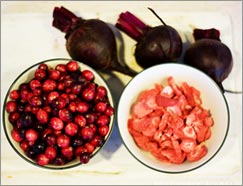 Natural food colors refer to the dyes obtained from vegetables, animals or minerals, capable of coloring food, drugs or cosmetics. The name 'natural food colors' stands correct as all these natural food colors are obtained using only naturally available products. Usually they are extracted from natural things like seeds, fruits, vegetables, leaves, insects, algae, etc.
Natural food colors refer to the dyes obtained from vegetables, animals or minerals, capable of coloring food, drugs or cosmetics. The name 'natural food colors' stands correct as all these natural food colors are obtained using only naturally available products. Usually they are extracted from natural things like seeds, fruits, vegetables, leaves, insects, algae, etc.Another very important characteristic of the natural food colors is that they are safe to use as food additives. Since they are natural derivatives, they are free of any harmful side effects. They might be harmful to those who suffer from certain allergies and intolerances. But such allergies are usually individual problems and do not generalize. Natural food colors are popularly food additives that can be found in everyday consumption products.
As per FDA color pigments having a natural origin are exempt from certification. It does not carry any categorization as natural or synthetic. The reason is that the source may be natural but it may or may not be natural to the food it is added to. There are 26 colors permitted to be used in food and 28 to be used in cosmetics and pharmaceuticals. A few commonly used natural colors are Annatto(seed), turmeric, beet juice (root), red Cabbage (vegetable), spinach (leaf) and caramel. All these colors are obtained from some or the other natural products. Easy availability of these food dyes is also one of the reasons for their popularity. But the driving reason behind the growing demand of of natural food colors is the concern that revolves around the synthetic food colors like tartrazine .
Also known as organic food colors, these natural food additives are made available to the people by the food industry. Natural food colors are being obtained, refined and then added to the edible substances. For use at home, purified forms of natural food colors and dyes are being available in packaged form. They are also easy to prepare at home. A number of natural food dyes can be easily prepared at home. For example, saffron and dark yellow color can be prepared easily by boiling saffron in water for around ten minutes, red color can be extracted from carrot, deep red from beet root, so and so forth. Asian spices like turmeric and saffron have been traditionally used in households for cooking everyday meals. They lend an appeasing color to the food.
Natural food colors suppliers and the natural food additives suppliers from India are making some Indian spices available all across the world. Specially the ones that are found and processed exclusively in India, or whose premium variants are found here. Check out the list of natural food colors, identified as the natural food colors and dyes as per the FDA.
没有评论:
发表评论